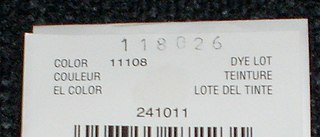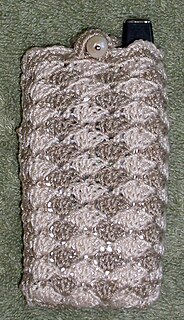
Crochet is a process of creating textiles by using a crochet hook to interlock loops of yarn, thread, or strands of other materials. The name is derived from the French term crochet, meaning 'small hook'. Hooks can be made from a variety of materials, such as metal, wood, bamboo, or plastic. The key difference between crochet and knitting, beyond the implements used for their production, is that each stitch in crochet is completed before the next one is begun, while knitting keeps many stitches open at a time. Some variant forms of crochet, such as Tunisian crochet and broomstick lace, do keep multiple crochet stitches open at a time.

Knitting is a method by which yarn is manipulated to create a textile, or fabric. It is used to create many types of garments. Knitting may be done by hand or by machine.
Yarn is a long continuous length of interlocked fibres, suitable for use in the production of textiles, sewing, crocheting, knitting, weaving, embroidery, or ropemaking. Thread is a type of yarn intended for sewing by hand or machine. Modern manufactured sewing threads may be finished with wax or other lubricants to withstand the stresses involved in sewing. Embroidery threads are yarns specifically designed for needlework.

A knitting needle or knitting pin is a tool in hand-knitting to produce knitted fabrics. They generally have a long shaft and taper at their end, but they are not nearly as sharp as sewing needles. Their purpose is two-fold. The long shaft holds the active (unsecured) stitches of the fabric, to prevent them from unravelling, whereas the tapered ends are used to form new stitches. Most commonly, a new stitch is formed by inserting the tapered end through an active stitch, catching a loop of fresh yarn and drawing it through the stitch; this secures the initial stitch and forms a new active stitch in its place. In specialized forms of knitting the needle may be passed between active stitches being held on another needle, or indeed between/through inactive stitches that have been knit previously.
A crochet hook is an implement used to make loops in thread or yarn and to interlock them into crochet stitches. It is basically a round shaft pointed on one end, with a lateral groove behind it. The point eases the insertion of the hook through the material being crocheted and the groove makes it possible to pull a loop back through the material. The shaft is then divided into a working area that determines the hook's nominal diameter and ensures the uniform sizing of the loops formed on it, and a handle.
Broomstick lace, also known as jiffy lace and peacock eye crochet, is a historic crochet technique from the 19th century which is done using a crochet hook and another long slender item such as a knitting needle. Traditionally a broomstick was used, hence the name, but the modern variant is a lightweight plastic knitting needle or smooth wooden craft dowel. A larger knitting needle or dowel will result in a lacier effect, while a smaller will provide a more closely woven effect. Because the fabric created is soft yet stable, it is well-suited for clothing and blankets.

Nålebinding is a fabric creation technique predating both knitting and crochet. Also known in English as "knotless netting," "knotless knitting," or "single needle knitting," the technique is distinct from crochet in that it involves passing the full length of the working thread through each loop, unlike crochet where the work is formed only of loops, never involving the free end. It also differs from knitting in that lengths must be pieced together during the process of nålebinding, rather than a continuous strand of yarn that can easily be pulled out. Archaeological specimens of fabric made by nålebinding can be difficult to distinguish from knitted fabric.
In knitting, the word gauge is used both in hand knitting and machine knitting; the latter, technical abbreviation GG, refers to "Knitting Machines" fineness size. In both cases, the term refers to the number of stitches per inch, not the size of the finished garment. In both cases, the gauge is measured by counting the number of stitches or the number of needles over several inches then dividing by the number of inches in the width of the sample.

Rug hooking is both an art and a craft where rugs are made by pulling loops of yarn or fabric through a stiff woven base such as burlap, linen, or rug warp. The loops are pulled through the backing material by using a crochet-type hook mounted in a handle for leverage. In contrast latch-hooking uses a hinged hook to form a knotted pile from short, pre-cut pieces of yarn.

In knitting, crochet and other textile arts, blocking is a final stage of handmade textile production that adjusts the shape of the finished piece. Not all pieces need blocking; however, blocking is standard for lace work and is not uncommon in sweaters, socks, and other solid projects. Through heat and moisture, blocking sets the stitches and standardizes the final dimensions, and may enhance the drape. Hand manufacture places natural stresses on fabrics that may result in deviations from its intended shape and size. Blocking is only effective on natural fibres but a technique called "killing" may be used on synthetic fibres to achieve an effect similar to blocking.
The manufacture of textiles is one of the oldest of human technologies. To make textiles, the first requirement is a source of fiber from which a yarn can be made, primarily by spinning. The yarn is processed by knitting or weaving, which turns yarn into cloth. The machine used for weaving is the loom. For decoration, the process of colouring yarn or the finished material is dyeing. For more information of the various steps, see textile manufacturing.

A granny square is a piece of square fabric produced in crochet by working in rounds from the center outward. Granny squares are traditionally handmade. They resemble coarse lace. Although there is no theoretical limit to the maximum size of a granny square, crocheters usually create multiple small squares and assemble the pieces to make clothing, purses, Afghan blankets, and other household textiles.

A dye lot is a record taken during the dyeing of yarn to identify yarn that received its coloration in the same vat at the same time. Yarn manufacturers assign each lot a unique identification number and stamp it on the label before shipping. Slight differences in temperature, dyeing time, and other factors can result in different shades of the same color between different dye lots of otherwise identical production. Although the component elements of a dye lot number are of interest only for internal business recordkeeping, retail yarn consumers have an interest in ensuring that they purchase a given color of yarn from identical dye lots.

Crochet thread is specially formulated thread usually made from mercerized cotton for crafting decorative crochet items such as doilies or filet crochet. Crochet thread produces fabric of fine gauge that may be stiffened with starch.

In crochet, a stitch marker is a mnemonic device used to distinguish important locations on a work in progress. Crochet patterns have a mathematical basis, so stitch markers serve as a visual reference that takes the place of continuous stitch counting and reduces a crocheter's error rate.

A shell stitch is a crochet motif often used as a border around other patterns or in staggered rows to create a distinctive fabric pattern. Shell stitches take the shape of arcs and semicircles, hence the name. Shell stitches are often used as edging for crocheted items such as Afghan blankets and sweaters.
Hand knitting is a form of knitting, in which the knitted fabric is produced by hand using needles.
Yarn weight refers to the thickness of yarn used by knitters, weavers, crocheters and other fiber artists.













